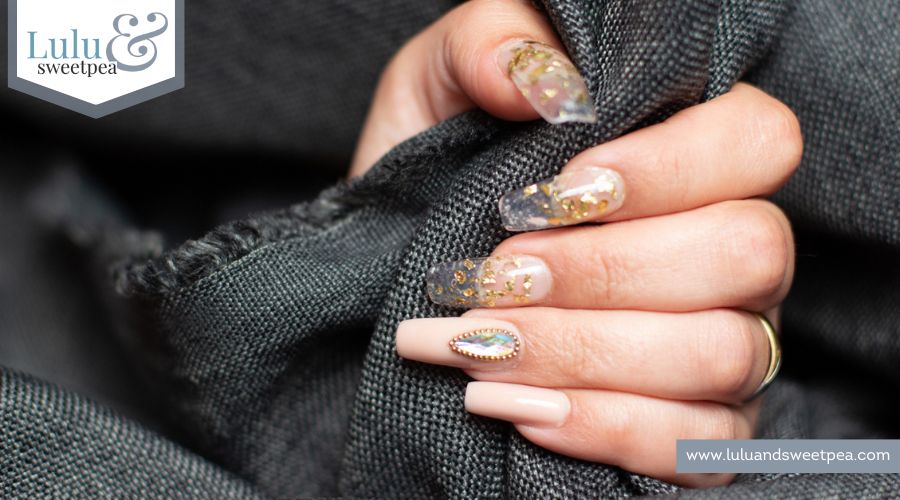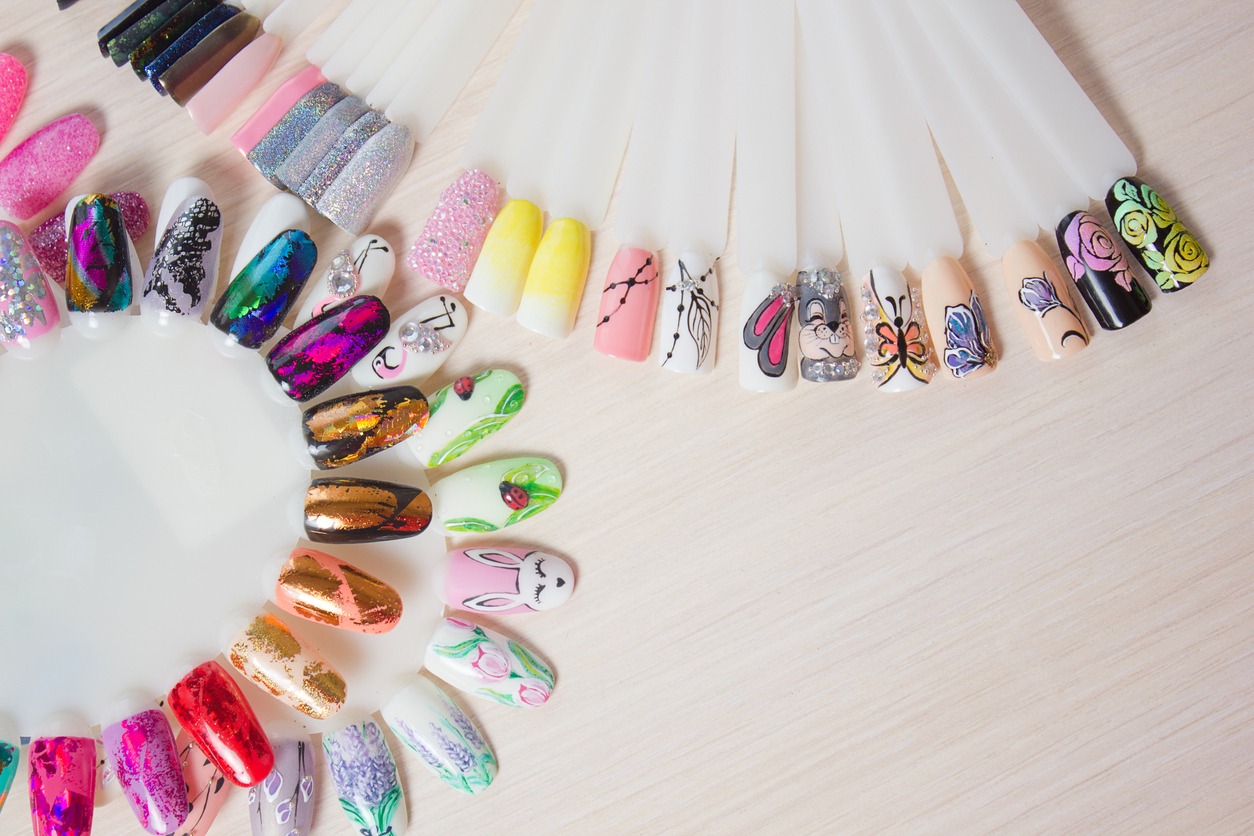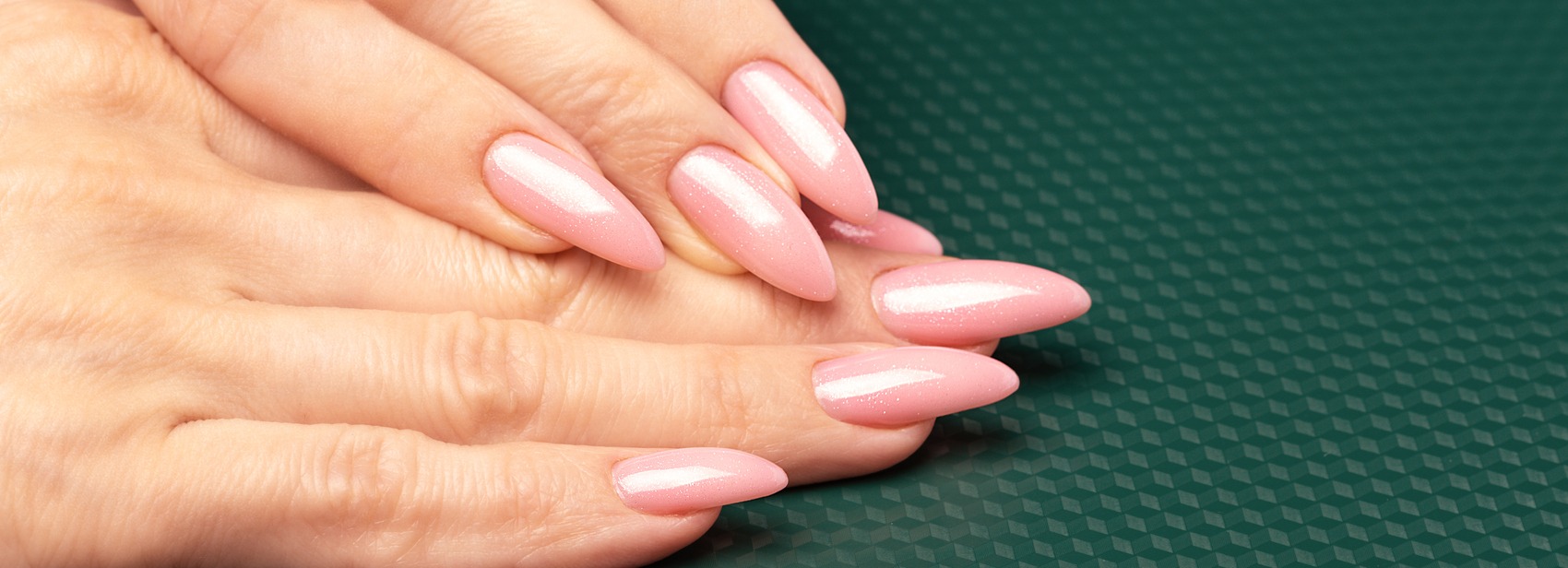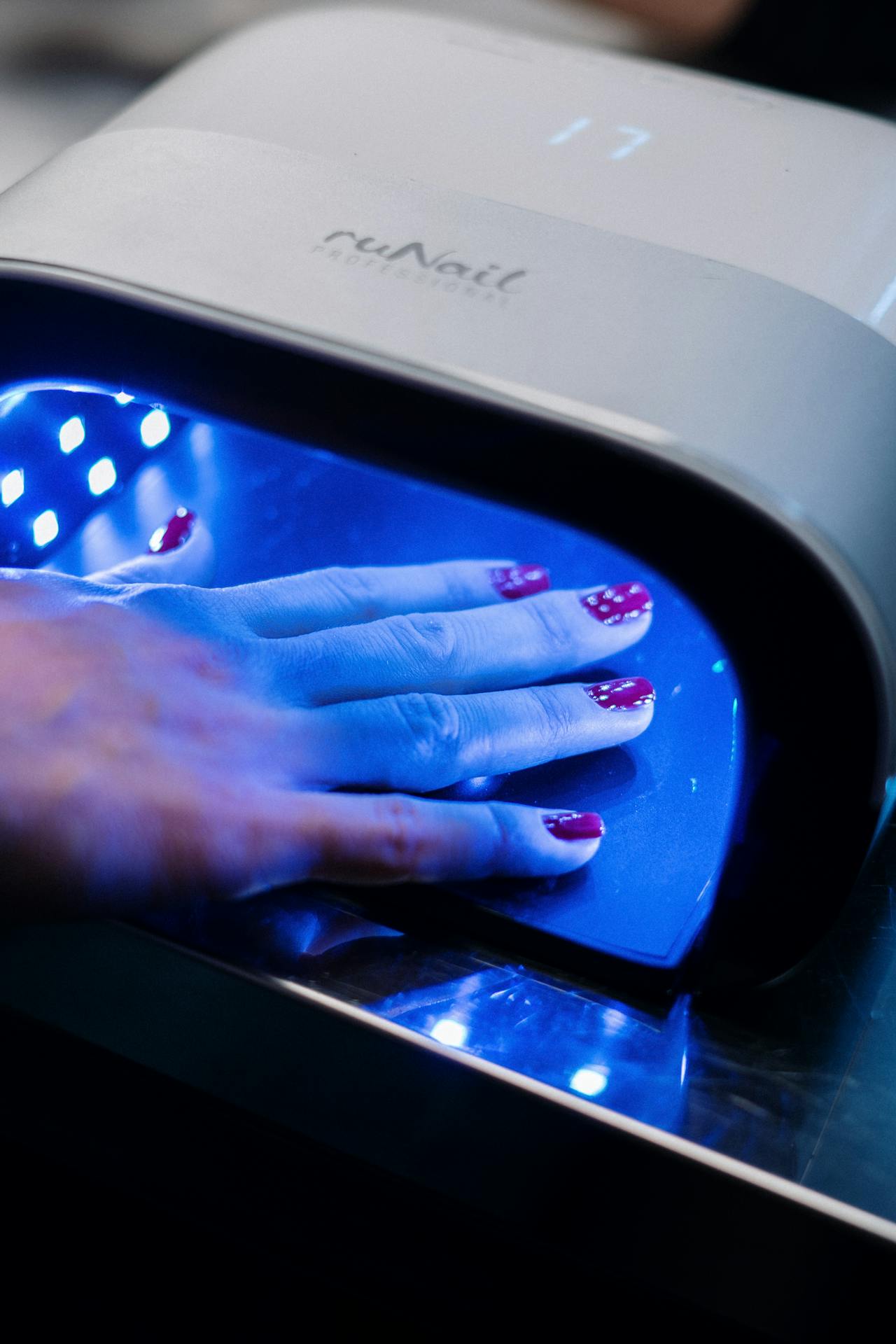When deciding between gel and acrylic nails, it’s important to consider the longevity, appearance, and maintenance of each option. Gel nails are prized for their glossy finish and a more natural look, which appeals to those seeking a durable manicure with a cleaner aesthetic. The process of applying gel nails involves curing under a UV or LED lamp, resulting in a hard, chip-resistant coating that can last up to two weeks without significant wear.
Acrylic nails, on the other hand, are known for their sturdiness and versatility in design. This method combines a liquid monomer and a powder polymer to create a hard protective layer over the natural nails that can be shaped and styled in various ways. Acrylic nails are typically more affordable and might be the preferable choice for individuals with an active lifestyle due to their durability. However, they come with a less natural appearance than gel nails and require regular fill-ins as the natural nail grows.
Understanding Nail Enhancements
When deciding between gel and acrylic nails, it is important to understand their composition, application, and structural differences. Each of these nail enhancements offers unique benefits and considerations.
Acrylic Nails: Composition and Application
Acrylic nails are created with a mixture of liquid monomer and powder polymer that, when combined, form a hard protective layer over natural nails. The application process typically involves a nail technician at a salon sculpting the acrylics onto the nails using a brush. Once applied, the mixture hardens by air without the need for a lamp. This process creates a strong and durable nail enhancement that can be molded and shaped to the desired look.
Gel Nails: Properties and Curing
Gel nails utilize gel nail polish, which is a type of soft gel. This substance is applied in layers and then cured under either a UV or an LED lamp, with each layer requiring a drying time to achieve polymerization (the process that solidifies the gel). Gel nail enhancements come in two forms: hard gel and soft gel. Hard gel can provide a similar strength to acrylics once cured, whereas soft gel is more flexible.
Comparing Structural Differences
The primary differences between gel and acrylic nails lie in their structural integrity, flexibility, and application processes. Acrylic nails are known for their strength, but can be brittle and less flexible, which may not be suitable for those with weaker nails. On the other hand, gel nails provide a more natural look and have more flexibility, but they usually require more frequent maintenance. The choice between gel and acrylic should be based on the individual’s nail health and lifestyle needs.
Appearance and Aesthetics
When evaluating gel and acrylic nails, one must consider their visual appeal and customization options, as these attributes significantly influence individual style choices.
Visual Appeal of Acrylic and Gel Nails
Acrylic nails are known for their durability and versatility in nail art. The material’s thickness often results in a more pronounced, sculpted look that can hold shapes such as oval or square well. Additionally, acrylics can be painted with a wide variety of colors and patterns, satisfying diverse nail trends.
In contrast, gel nails boast a glossy finish that resembles a fresh coat of nail polish, often creating a more natural look. Their shine is inherent to the gel itself, which can enhance the visual depth of the nail’s color. They’re particularly favored for a sleek, modern aesthetic and are commonly used in nail art due to their luster.
Shaping and Customization Options
Both gel and acrylic nails offer extensive customization options, but the processes differ:
- Acrylics: Can be shaped and filed into various lengths and forms. Nail artists can add decorations or additional art after the acrylic has set. The material’s strength allows it to serve as a durable base for heavy or 3D adornments.Shaping options: oval, square, stiletto, and more.
- Gel nails: They may be less accommodating for complex shaping but excel in providing a seamless extension of the natural nail. The shaping is typically done before curing under UV light, which can limit adjustment post-application.Nail extensions: Slight to moderate, favoring a look consistent with natural nail growth patterns.
By considering these factors, individuals can choose the type of artificial nail that best meets their aesthetics and styling needs.
Health Considerations
When opting for gel or acrylic nails, it is crucial for individuals to consider the effects these treatments may have on the long-term health of their nails and surrounding skin. A balance between aesthetic desires and nail care should guide decisions, with emphasis on avoiding unnecessary damage and reducing the risk of infection.
Impact on Natural Nails and Cuticles
Natural Nail Integrity: Frequent applications of acrylic nails entail using harsh chemicals and adhesives, which can weaken the natural nail over time. They require a roughening of the nail surface for proper adhesion, which, coupled with the stress of removal, may lead to thinning and brittleness.
Cuticle Health: Both gel and acrylic nail applications involve cuticles, the protective layer for the nail bed. An esthetician must be careful not to damage cuticles during the application process. Improper handling or cutting of cuticles might increase the risk of infection and impact nail growth.
Safety and Risks of Infection
Protective Measures: Sanitization of tools and proper care practices by the esthetician greatly reduce the risk of infection. It is imperative that instruments are sterilized between clients. Single-use items should be disposed of immediately after use.
Chemical Exposure: Clients are exposed to ultraviolet (UV) light when curing gel nails, and though the exposure per session is minimal, prolonged use raises concerns about potential risks. For acrylics, the inhalation of fumes from acrylic nail products can be harmful, and proper ventilation in the salon is essential to minimize inhalation of these harsh chemicals.
Durability and Maintenance
When deciding between gel and acrylic nails, one needs to consider their inherent durability and the maintenance each type requires. These factors are influenced by nail trends, individual lifestyle, and the desired commitment to nail care.
Longevity and Wear Resistance
Acrylic nails are notable for their robustness and wear resistance, making them a go-to option for those with an active lifestyle. They are renowned for being long-lasting and can endure the wear and tear of daily activities. A key advantage of acrylics is their ability to remain chip-free for extended periods, usually needing a fill-in every 2 to 3 weeks to maintain appearance as the natural nail grows.
On the other hand, gel nails also offer a durable wear but typically have a shorter longevity compared to acrylics. They are prized for their glossy finish and are less prone to chipping. However, gel polish may require more frequent visits to the salon for maintenance to sustain their pristine condition.
Ongoing Care Requirements
The ongoing care for acrylic nails includes regular maintenance such as fill-ins, as previously mentioned. To protect your nails, one should moisturize regularly and apply cuticle oil to keep the nails and surrounding skin healthy. This routine care helps prevent lifting and extends the lifespan of the acrylics.
Gel nails demand a different kind of maintenance. They necessitate the use of cuticle oil to maintain moisture around the nails, preventing brittleness and cracking of the gel. Regular maintenance is key, alongside adequate protection from harsh activities that could compromise the integrity of the gel. It’s important to note that exposing gel nails to harsh chemicals without protection can lead to premature wear.
Each nail type requires one to commit to a maintenance routine to ensure their longevity and to keep them looking fresh. Whether one chooses gel or acrylic nails will largely depend on their lifestyle, desired frequency of salon visits, and commitment to at-home care.
Application and Removals
When considering gel vs. acrylic nails, the intricacies of the application and removal processes are pivotal. Acrylic nails require a blend of liquid monomer and powder polymer, while gel nails involve curing under UV light. Both demand skillful techniques for application and safe, effective removals to maintain nail health.
Processes of Applying Acrylic and Gel
Acrylic Nails:
- Preparation: Nails are cleaned, filed, and a primer is applied.
- Application: A mixture of liquid monomer and powder polymer is applied to natural nails or extensions and shaped.
- Drying: The acrylic hardens by air drying.
- Finishing Touches: A base coat is followed by nail polish and a top coat.
Gel Nails:
- Preparation: Similar to acrylics, nails are prepped with cleaning and filing.
- Application: A pre-mixed gel is applied in layers.
- Curing: Each layer is cured under UV light to harden.
- Sealing: The manicure is completed with a top coat for gloss and protection.
Techniques for Safe Removal
Acrylic Nails:
- Acetone Soak: Nails are soaked in acetone, often using cotton balls and aluminum foil to hold the acetone in place.
- Gentle Removal: Once the acrylic has softened, it is carefully lifted from the natural nail to avoid damage.
Gel Nails:
- Filing: The seal of the gel top coat is broken by filing.
- Acetone Soak: Similar to acrylics, nails are soaked in acetone for removal.
- Careful Pressure: The nail technician applies pressure to gently push the gel off the nail bed.
Both removal processes require patience and meticulous care to preserve the integrity of the natural nails. It’s worth noting that nail trends influence the choice of manicure but should not compromise the health and safety of the nail during application and removal.
Cost Analysis
When evaluating the financial implications of gel and acrylic nails, one must consider both the immediate cost at the nail salon and the ongoing expenses related to maintenance.
Comparing Upfront Service Costs
Gel Nails:
- Average initial cost: $50 – $80
- Factors influencing price: expertise of the nail technician, salon reputation, and geographic location.
Acrylic Nails:
- Average initial cost: $35 – $45
- Less expensive due to the materials used and the widespread availability of the service.
Long-Term Financial Considerations
Gel Nails:
- Maintenance: requires regular upkeep every 2-3 weeks.
- Cost of maintenance: similar to initial installation, potentially adding up to a higher long-term expense.
Acrylic Nails:
- Refills: needed every 2-3 weeks which can be less costly than new sets of gel nails.
- Longevity: may prove more budget-friendly over time due to lower cost of refills compared to gel maintenance.
It’s important for individuals to weigh the upfront cost against the regular maintenance expenses to determine which nail technique aligns with their lifestyle, personal preference, and budget. Affordability can differ significantly based on individual needs for nail care and frequency of salon visits.
Lifestyle and Preferences
Choosing between gel and acrylic nails often comes down to one’s everyday activities and individual sense of style. How a person lives and what they personally find appealing can greatly influence their nail choice.
Aligning Nail Choices with Lifestyle
Natural Nails Consideration: Individuals who participate in vigorous activities or have jobs that involve manual labor may prefer acrylic nails due to their strength and durability. Acrylics are known to withstand the wear and tear that comes from a more active lifestyle. However, for those seeking to maintain the health of their natural nails, gels might be the better choice, as they often require less filing of the natural nail during application.
Maintenance and Lifespan: For those with a busy lifestyle, gel nails might be appealing due to their quick curing time under UV or LED light. Acrylic nails, on the other hand, demand a longer appointment for both application and removal, which could be less convenient for some.
Personal Preference and Aesthetics
Appearance and Trends: The preference for a more natural-looking manicure may lead someone to choose gel nails, which typically have a glossier finish and softer appearance. Acrylics, however, offer versatility in shape and length, which can be ideal for clients wishing to experiment with bold nail art trends.
Aestheticians’ Expertise: A good esthetician can guide clients toward the perfect choice based on the client’s personal preferences and the desired final appearance. Whether the client prefers a vibrant polish, a sophisticated French manicure, or intricate nail art, pros and cons exist for each nail system as per the individual’s desires.
In summary, when choosing between gel and acrylic nails, it’s essential to consider one’s lifestyle in terms of activity level and maintenance preference, as well as aesthetic** preferences** for the final look of the manicure.
Expert Opinions
When determining whether gel or acrylic nails are the better option, the perspectives of nail technicians and estheticians are invaluable. They assess client needs, consider nail care practices, and stay abreast of the latest nail trends to provide tailored recommendations.
Nail Tech Insights:
- Gel nails: Nail artists often recommend gel nails for their glossy finish and quick curing time under UV light. Gel is also known for its flexible nature, which may feel more natural on the nails.
- Acrylic nails: Acrylics are favored by many experts for their durability and longevity. Nail technicians value acrylics for their strength, making them suitable for lengthening short nails or providing a sturdy canvas for nail art.
Preference Considerations:
- Client Lifestyle: A nail technician will consider the client’s daily routine. Acrylics might be suggested for individuals with a more hands-on job, while gel could be better for those seeking a short-term, aesthetically pleasing option.
- Maintenance Level: Nail care experts know that acrylics require regular filling, while gel nails might demand less frequent, but more meticulous, maintenance.
Trend Influence:
- Expert estheticians and nail artists recognize that trends influence client requests. They remain neutral and provide the best advice, regardless of popularity, focusing on nail health and client satisfaction over trend conformity.
By staying informed on these preferences and considerations, nail care professionals confidently guide clients in choosing between gel and acrylic options, according to personal needs and lifestyles.
Conclusion
When it comes to choosing between gel and acrylic nails, the decision is highly personal and depends on one’s lifestyle, nail health, and aesthetic preferences. Gel nails are revered for their natural look and glossy finish. They typically provide a more flexible overlay, which can be more comfortable for some users. Their durability is notable; they often resist chipping for up to two weeks.
Acrylic nails, on the other hand, are known for their strength and longevity. They are a versatile option allowing for easy reshaping and refilling, making them cost-effective for those seeking a long-term nail enhancement solution. However, they are stiffer than gel nails, which may not be suitable for everyone.
| Feature | Gel Nails | Acrylic Nails |
|---|---|---|
| Appearance | Natural and glossy | Less natural than gel nails |
| Flexibility | More flexible | Stiffer |
| Durability | Up to two weeks without chip | Highly durable |
| Maintenance | Moderate | Refilling needed over time |
| Removal | Easier than acrylic | Can be tough on nails |
Individuals with active lifestyles may favor gel nails for their flexibility, while those seeking a more durable option that withstands rigorous activities may opt for acrylics. Both options require professional removal to prevent damage to the natural nails. It is always advisable to consult with a manicurist to align the type of nail enhancement with one’s personal nail care needs.
Additional Considerations
When choosing between gel and acrylic nails, one must consider the application process and maintenance requirements. Acrylic nails involve a combination of a liquid monomer and a powder polymer that creates a hard protective layer over the natural nail. In contrast, gel nails are applied in layers and then cured under a UV or LED lamp.
Durability and Maintenance:
- Acrylic nails tend to be more durable and can last longer between fills.
- Gel nails might experience peeling or cracking if not cured properly or due to heavy impact.
Application Techniques:
- Gel extensions are typically pre-shaped tips adhered to the natural nail with glue, then overlaid with gel polish.
- Dip powder nails, while not acrylic or gel, are a hybrid that involves dipping the nail into a colored powder and then sealing it with a clear protective polish.
Health and Safety:
- Use of cuticle oil is recommended to maintain nail health for both gel and acrylic nails.
- A fan or proper ventilation is advisable during application to disperse strong odors and fumes from the liquid acrylic.
Aesthetics:
- Gel nails often offer a glossier finish than traditional nail polish.
- Acrylics provide a wide range of customization, including nail trends, colors, and shapes.
Flexibility vs. Strength:
- Gel nails typically offer more flexibility, yet they may not be as strong as acrylic nails.
- Acrylics are known for their strength but can be less flexible, which some wearers might find uncomfortable.
Care regimen and personal preference are pivotal in the decision-making process. It’s important to consider lifestyle, desired maintenance level, and aesthetic preference when selecting the right type of nail enhancement.
Technical Aspects of Nail Products
Gel and acrylic nails involve different chemical formulas and application processes, each with specific technical requirements. Gel nails, for example, typically utilize a pre-mixed gel formula that requires curing under UV or LED light to harden and set the product.
- UV light curing: Requires longer exposure (around 2 minutes)
- LED light curing: Faster process (approximately 30 seconds)
Gel nail products can range from soft to hard gels, with the former being more flexible and the latter more resistant, resembling the strength of acrylic nails.
On the other hand, acrylic nails involve a two-component system featuring a liquid monomer and a powder polymer that, when combined, form a malleable bead. This mixture is applied and sculpted onto the natural nail or a nail extension and then air-dried.
| Acrylic Component | Function |
|---|---|
| Liquid Monomer | A solvent that enables the powder to form a pliable bead |
| Powder Polymer | Reacts with monomer to create the hard material that forms the nail |
Acrylic nails are appreciated for their durability and versatility, offering a wealth of possibilities for designs and shapes. However, it requires skillful application to ensure the correct ratio of liquid to powder and to avoid air bubbles or uneven surfaces.
Both systems have their advantages, and the choice between gel and acrylic nails often depends on the wearer’s lifestyle, nail health, and maintenance preferences. Safety precautions should be observed with both gel and acrylic nails, as improper use of UV light and exposure to monomers can pose potential risks.
Nail Art and Design
When choosing between gel and acrylic nails, one should consider their preferences for nail art and design. Gel nails often provide a glossy and smooth finish which serves as an excellent canvas for intricate nail art. They are known for their vast color range and the ability to blend shades with ease. Gel polish also tends to cure under a UV or LED light, resulting in quick drying that allows for immediate design work without smudging.
Acrylic nails, on the other hand, are favored by some for their sturdiness, which can be pivotal for 3D designs and embellishments. They have a long history of use in the nail industry, making them a classic choice for those looking for traditional nail art styles.
Here’s a quick comparison of the two in relation to nail art and design:
- Gel Nails:
- Provide a high-shine finish suitable for detailed art.
- Extensive palette of colors available.
- Quicker drying times prevent design distortion.
- Acrylic Nails
- Ideal for sculptural and 3D nail art.
- Can be easily shaped and filed to create unique designs.
- Known for durability, supporting heavier design elements.
Both gel and acrylic nails accommodate a broad spectrum of nail trends, from subtle French manicures to bold graphic patterns. Whether an individual chooses gel or acrylic largely depends on their personal design preferences, the desired longevity of the nail art, and the maintenance they are prepared to undertake.






